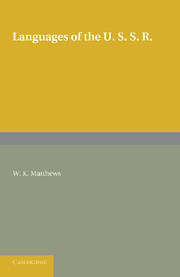Book contents
- Frontmatter
- Contents
- LIST OF ILLUSTRATIONS
- PREFACE
- Map
- Chapter I THE LINGUISTIC PATTERN
- Chapter II PALAEOASIATIG LANGUAGES
- Chapter III URALIAN LANGUAGES
- Chapter IV ALTAIC LANGUAGES
- Chapter V NORTH CAUCASIAN LANGUAGES
- Chapter VI SOUTH CAUCASIAN LANGUAGES
- Chapter VII INDO-EUROPEAN LANGUAGES
- Appendix I TABULAR SUMMARY
- Appendix II LANGUAGE STATISTICS
- Appendix III BIBLIOGRAPHY
- Appendix VI INDEX OF LANGUAGES AND DIALECTS
- Appendix V SYMBOLS AND PHONETIC VALUES
- INDEX
Chapter III - URALIAN LANGUAGES
Published online by Cambridge University Press: 05 June 2016
- Frontmatter
- Contents
- LIST OF ILLUSTRATIONS
- PREFACE
- Map
- Chapter I THE LINGUISTIC PATTERN
- Chapter II PALAEOASIATIG LANGUAGES
- Chapter III URALIAN LANGUAGES
- Chapter IV ALTAIC LANGUAGES
- Chapter V NORTH CAUCASIAN LANGUAGES
- Chapter VI SOUTH CAUCASIAN LANGUAGES
- Chapter VII INDO-EUROPEAN LANGUAGES
- Appendix I TABULAR SUMMARY
- Appendix II LANGUAGE STATISTICS
- Appendix III BIBLIOGRAPHY
- Appendix VI INDEX OF LANGUAGES AND DIALECTS
- Appendix V SYMBOLS AND PHONETIC VALUES
- INDEX
Summary
Against the Palaeoasiatic zone, which follows the Pacific littoral, two genetic stocks abut in broad, horizontal bands, viz. the Uralian, stretching across tundra and taiga from the Baltic Sea to Yakutia, and the Altaic, stretching across steppe and sand from the Crimea to the relatively recent Tungus (Lamut) lands of the Sea of Okhotsk.
Since the earlier half of the nineteenth century, when Castrén, Hunfalvy, and Böhtlingk accepted W. Schott's ‘Uralo-Altaic’ hypothesis, correlating Uralian and Altaic genetically in virtue of shared vowel harmony, and since the later and more considered views of H. Winkler, who extended the linguistic limits of the complex to include Korean and Japanese, attempts have not been lacking (e.g. A. Sauvageot's) to establish a Uralo-Altaic unity, in spite of O. Donner's insistence on the obvious need for a preliminary detailed study of individual languages. Unfortunately, and notwithstanding the recent valuable work of Soviet scholars, the absence of an adequate comparative grammar of the two stocks, especially of Altaic, makes it impossible to go beyond superficial speculations, and the existing dichotomy of Uralian and Altaic must be allowed to remain. Centuries of geographical proximity have no doubt contributed something to the undeniable, if vague, likeness between them. Vowel harmony (synharmonism) characterises most languages of both stocks; there are widespread traces of the Uralian type of consonantal alternation (Stufenwechsel, Finn, astevaihtelu, Hung, fokváltakozás) discovered by E. N. Setälä the phonetic systems exhibit points of resemblance (e.g. the occurrence of rounded front vowels and the avoidance of initial consonant-groups); the morphological features include agglutination in various stages of development; there are similar personal pronouns; and some investigators have even collected a skeleton common vocabulary of words expressing rudimentary nominal and verbal notions, but excluding the numerals.
The Uralian languages of the U.S.S.R. separate into three branches—Samoyedic, Ugrian, and Finnic (Somian). The essential unity of the Samoyedic dialects or languages with Ugrian and Finnic was confirmed in epitome a generation ago by E. N. Setälä. It is obvious not only in structure but in vocabulary (cf. Yur. Sam. sawa ‘good’, jaha ‘river’, maņ, ‘I’, lb ‘bone’, jileş ‘to live’, tu ‘fire’, haļa ‘fish’, pa ‘tree’, ne ‘woman’, jaBeş ‘to drink’, Tav. Sam. ņim ‘name’, Ost. Sam. pelæek ‘half’, with the corresponding words in Finnish, viz.
- Type
- Chapter
- Information
- Languages of the USSR , pp. 14 - 51Publisher: Cambridge University PressPrint publication year: 2013



